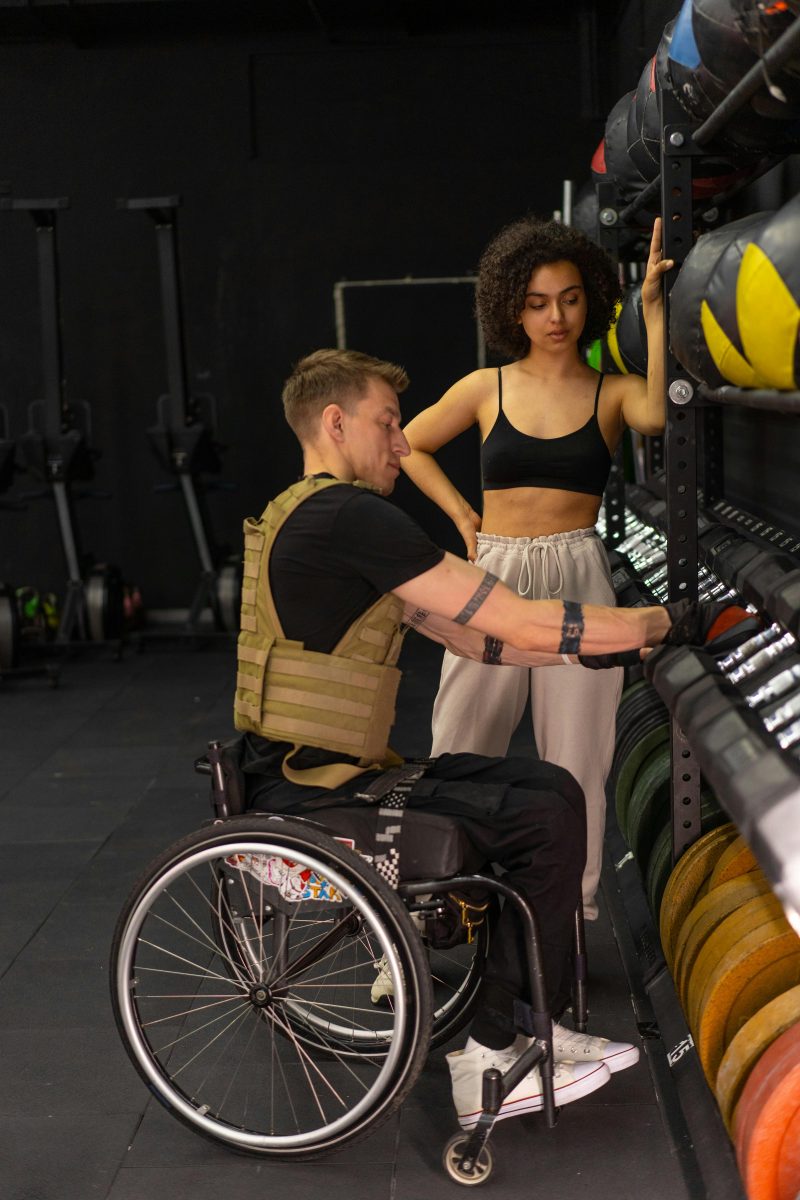Last Updated on: 14th July 2024, 09:38 am
Introduction to Advanced Weight Training

As athletes progress, the need to evolve their training regimen becomes paramount. Stagnation is the enemy of progress. Advanced weight training introduces techniques that push the boundaries, challenging the body in new and demanding ways. This evolution is not just beneficial; it’s essential for those looking to break through plateaus and achieve peak performance.
- Variations of traditional lifts
- Use of unconventional equipment
- Focus on precision and mind-muscle connection
Embracing these advanced techniques requires dedication and a willingness to step outside one’s comfort zone. The rewards, however, are well worth the effort. With each new challenge overcome, athletes find themselves closer to their ultimate potential.
Periodization: Maximizing Muscle Growth and Strength

At the heart of transcending physical limits lies a strategic approach known as periodization. This method systematically structures training phases, ensuring muscles are constantly challenged through varied stimuli. The essence of periodization is to prevent plateaus, a common adversary for advanced athletes, by meticulously planning workout intensity, volume, and recovery. It’s a game-changer for those aiming to maximize muscle growth and strength.
Understanding the Concept of Periodization
Periodization divides training into specific periods or cycles, each with a distinct focus. Initially developed for athletes, this approach has proven its worth across all levels of fitness enthusiasts. It’s about smart training, not just hard training. By aligning training goals with these cycles, athletes can achieve peak performance at just the right time.
Types of Periodization
- Linear periodization – Gradually increases intensity while decreasing volume.
- Non-linear/block periodization – Focuses on varying the training focus every few weeks.
- Undulating periodization – Alternates training focus on a daily or weekly basis.
Implementing Periodization in Your Training Plan
Incorporating periodization into your training regimen requires a thoughtful approach. Start by defining your long-term goals, then break these down into manageable cycles. Each cycle should aim to build upon the last, gradually increasing in intensity and complexity. This strategic variation not only maximizes muscle growth and strength but also significantly reduces the risk of overtraining and injury. It’s a powerful tool that, when wielded correctly, can propel athletes towards their peak potential.
Embracing periodization is a testament to an athlete’s commitment to excellence. It’s a sophisticated technique that, when integrated with other advanced training methods, forms a comprehensive approach to achieving unparalleled physical prowess. The journey to the apex of athletic performance is complex, but with periodization, it’s a well-navigated path.
Advanced Lifting Techniques for Peak Performance

Eccentric Loading for Muscle Hypertrophy
Eccentric loading, the phase where the muscle elongates under tension, is a powerhouse for muscle growth. By focusing on the controlled lowering of weights, athletes can induce significant hypertrophy. This technique not only increases muscle size but also enhances strength, making it a dual-threat in the weight room.
Paused Reps for Strength and Control
Integrating paused reps into a routine forces muscles to halt and hold under load, amplifying strength and control. This pause, typically at the most challenging part of the lift, ignites muscle fibers to their fullest, pushing the boundaries of muscular endurance and power. It’s a testament to the saying, “control the weight, don’t let the weight control you.”
Cluster Sets for Endurance and Power
Cluster sets, short bursts of reps followed by brief rest periods within a single set, turbocharge endurance and power. This technique allows for the maintenance of high-intensity efforts, promoting greater volume at a higher intensity. The result? A significant boost in muscular endurance and explosive power, essential for athletes aiming to excel.
The Role of Plyometrics in Weight Training
Plyometrics, often termed “jump training,” integrates seamlessly with weight training to enhance explosive power. By performing high-velocity movements, athletes can improve their neuromuscular efficiency, translating to better performance in lifts. Incorporating plyometrics can bridge the gap between strength and speed, making it a critical component of an advanced athlete’s regimen.
Advanced lifting techniques like eccentric loading, paused reps, cluster sets, and plyometrics are not just exercises. They are tools, meticulously designed to sculpt an athlete’s physique and enhance performance. When wielded with precision, these techniques can elevate an athlete’s training, pushing them beyond the realms of ordinary, into the extraordinary. The journey of an athlete is one of constant evolution, and with these advanced techniques, the path to peak performance is both challenging and rewarding.
The Significance of Recovery in Advanced Training

Active Recovery and Its Benefits
Active recovery, a cornerstone of advanced training, involves low-intensity exercise following rigorous workouts. This method enhances blood flow, facilitating the removal of lactic acid and reducing muscle soreness. By engaging in activities such as light jogging or swimming, athletes can expedite their recovery process, ensuring they’re prepared for their next high-intensity session.
The Impact of Sleep on Muscle Recovery
Sleep, often underrated, plays a pivotal role in muscle recovery. During deep sleep, the body releases growth hormones essential for repairing and building muscle tissue. Achieving 7-9 hours of quality sleep nightly not only aids in physical recovery but also sharpens mental focus, a critical component for athletes aiming for peak performance.
Nutrition’s Role in Optimizing Recovery
Nutrition cannot be overlooked when discussing recovery. Consuming the right balance of proteins, carbohydrates, and fats aids in the repair of muscle fibers and replenishment of energy stores. Hydration, too, is crucial, as water supports metabolic functions and nutrient transfer. By prioritizing post-workout nutrition, athletes can significantly enhance their recovery, setting the stage for sustained progress.
Recovery is not merely a pause in training; it’s an integral part of an athlete’s journey towards excellence. Active recovery, adequate sleep, and proper nutrition form the triad of effective recovery strategies. Together, they ensure athletes remain resilient, ready to tackle the demands of advanced training head-on. Embracing these recovery techniques is essential for those committed to pushing their limits and achieving their full potential.
Incorporating Unconventional Training Equipment for Advanced Athletes

Benefits of Using Chains and Bands
Chains and bands add a unique resistance curve to weightlifting, intensifying the exercise as the lift progresses. This variable resistance ensures muscles are under constant tension, promoting strength gains and muscle hypertrophy. By attaching chains to barbells or looping bands around weights, athletes can experience a challenging workout that pushes their limits and encourages adaptation.
How to Integrate Kettlebells for Functional Strength
Kettlebells, with their off-center mass, demand balance and coordination, making them perfect for enhancing functional strength. Incorporating kettlebell swings, snatches, and Turkish get-ups into routines not only builds muscle but also improves flexibility and explosive power. These dynamic movements engage multiple muscle groups, offering a comprehensive workout that mirrors real-world activities.
The Advantages of Suspension Training
Suspension training harnesses body weight to create resistance, allowing for a full range of motion and targeting often neglected stabilizing muscles. Exercises performed on suspension straps can be easily adjusted to suit any fitness level, making them a versatile tool for advanced athletes. This form of training enhances core strength, balance, and flexibility, contributing to a well-rounded athletic performance.
Integrating unconventional equipment like chains, bands, kettlebells, and suspension training systems into an advanced athlete’s regimen can break the monotony of traditional weightlifting. These tools not only offer variety but also challenge the body in new ways, leading to significant gains in strength, endurance, and overall athletic ability. By stepping outside the conventional training box, athletes can unlock new levels of performance and achieve their peak potential.
Mental Strategies for Peak Performance

Setting Realistic and Challenging Goals
- Success in weight training is not just about lifting heavier weights; it’s about setting goals that are both realistic and challenging.
- Goals act as a roadmap, guiding athletes through their journey.
- By setting clear, attainable objectives, athletes can maintain focus and motivation, tracking their progress and celebrating their victories, no matter how small.
The Power of Visualization in Achieving Training Milestones
- Visualization is a potent tool that can prepare the mind for success.
- Athletes who mentally rehearse their lifts can enhance their confidence and technique.
- By vividly imagining each step of the exercise, from grip to movement, the body becomes primed to perform, often leading to improved outcomes in actual training sessions.
Coping Strategies for Overcoming Plateaus
- Plateaus are an inevitable part of any athlete’s journey, but they are not insurmountable.
- When progress stalls, it’s crucial to employ coping strategies.
- Adjusting one’s routine, seeking feedback from coaches, or even taking a short break can reignite progress.
- Remember, overcoming plateaus is a mental battle as much as a physical one.
These mental strategies are the silent partners to physical training. They fortify the mind, enabling athletes to push past their limits and achieve peak performance. When combined with advanced lifting techniques and recovery protocols, they complete the puzzle of an athlete’s success, ensuring that both mind and body are in harmony.
In Closing
Peak performance demands advanced training. This journey, while challenging, offers unparalleled rewards. Through a blend of sophisticated techniques and strategic recovery, athletes unlock their true potential, balancing rigor with resilience. Embracing periodization, unconventional equipment, and mental fortitude propels one towards excellence. Let this be a call to action: push beyond limits, for the path to greatness is forged by those who dare to challenge the ordinary.
Weight Training Techniques for Advanced Athletes FAQs
Advanced athletes can effectively track progress by keeping a detailed training log that includes exercises, weights, sets, reps, and any variations in their routine, along with regular assessments of strength, body composition, and performance metrics. This systematic approach allows for the evaluation of training effectiveness, identification of areas for improvement, and informed decision-making regarding program adjustments. Consistent tracking also helps in setting realistic goals and maintaining motivation.
Advanced athletes can overcome plateaus in weight training by altering their training variables, such as exercise selection, volume, intensity, and rest periods. Introducing new stimuli can help reignite muscle adaptation and growth, preventing stagnation. Periodically reassessing and adjusting the training program in response to progress and feedback is key to continuous improvement.
Advanced athletes can use supersets, which involve performing two exercises back-to-back with minimal rest, to increase workout intensity and efficiency. This technique can target the same muscle group with different exercises for muscle hypertrophy or can be used to work opposing muscle groups to improve muscular balance and endurance. Supersets not only save time but also elevate heart rate and increase calorie burn, contributing to improved cardiovascular fitness and fat loss.
Advanced athletes balance weight training with cardiovascular training by carefully scheduling cardio sessions to complement their strength training without compromising muscle recovery and growth. Low-intensity steady-state (LISS) cardio or high-intensity interval training (HIIT) can be strategically placed on rest days or after weight training sessions to enhance endurance and recovery while minimizing muscle fatigue. This balanced approach supports overall fitness, aids in body composition goals, and ensures sustained progress in both strength and cardiovascular health.
Plyometric exercises can be effectively incorporated into a weight training routine by scheduling them on the same day as lower body strength work or on a separate day if the focus is on maximal power development. These exercises enhance explosive power and speed, benefiting athletes by improving neuromuscular efficiency and force production. It’s crucial to ensure proper form and adequate recovery between plyometric sessions to prevent injury and maximize benefits.
Periodization is the systematic planning of athletic or physical training, aimed at dividing the training program into specific periods or cycles. This approach helps in maximizing performance and minimizing the risk of overtraining by varying the training intensity and volume. For advanced athletes, it allows for targeted improvements in strength, power, and endurance by focusing on different goals throughout the year.
Rest and recovery are crucial in an advanced weight training program to allow the body to repair and strengthen itself between workouts. Adequate rest helps prevent overtraining, reduces the risk of injury, and ensures muscle growth and performance improvements. Implementing active recovery days, ensuring sufficient sleep, and managing stress are key strategies to optimize recovery processes.
Flexibility and mobility work play a significant role in weight training for advanced athletes by enhancing movement efficiency and reducing the risk of injury. Incorporating dynamic stretches, mobility drills, and flexibility exercises into the training routine improves joint range of motion and muscular balance. This not only aids in performing exercises with proper form but also contributes to better overall athletic performance.
Mental toughness is significant in advanced weight training as it helps athletes push through challenging workouts, overcome setbacks, and stay committed to their goals. Developing a strong mindset enables the handling of high-intensity training demands and the discipline required for consistent progress. Strategies such as goal setting, visualization, and positive self-talk can enhance mental resilience and performance.
Nutrition plays a critical role in an advanced athlete’s weight training program by providing the necessary fuel and nutrients for recovery, muscle growth, and performance enhancement. Adequate intake of protein, carbohydrates, fats, and hydration supports the body’s repair processes, energy needs, and overall health. Tailoring nutrition to training demands can significantly impact an athlete’s ability to perform and recover from intense workouts.
Orlando is a all round athlete from Australia, now resident in Germany. His sports of passion of American Football(Offensive line), weight training and indoor rock climbing where he uses his 195cm wing span to his advantage.



